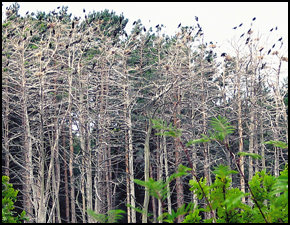Garnių ir kormoranų kolonija prie Juodkrantės
Tik išvažiavus iš Juodkrantės Nidos link, dar nepakilus į statųjį Avino kalną, sengirėje yra kitas – Garnių kalnas, vardą gavęs nuo netoliese įsikūrusios pilkųjų garnių ir didžiųjų kormoranų kolonijos. Tai viena didžiausių šių paukščių kolonijų visoje Europoje. 2000 metų duomenimis, joje perėjo 582 pilkųjų garnių ir 1361 didžiųjų kormoranų pora.
Vargu ar įmanoma atsakyti į klausimą, kada garniai apsigyveno Juodkrantės apylinkėse? XIX a. viduryje jie buvo įprasta kasdienybės detalė. Galima drąsiai tvirtinti, kad šie ilgakojai paukščiai gyveno XVII a. ar net gerokai seniau.
Kas paskatino garnius perkelti savo lizdavietes iš šiaurinių Juodkrantės apylinkių į pietines? Istoriniai šaltiniai pasakoja apie jų kovą su agresyviu atėjūnu – kormoranais. Kormoranai (Phalacrocorax carbo L. arba Carbo cormoranus), kitaip vadinami jūrų krankliais ”Corvus marinus”, Juodkrantėje pasirodė 1803 m. Jie apsigyveno greta garnių ir ėmė užiminėti šių lizdavietes. Palaipsniui garniai buvo išstumti į pakraščius. Jie pradėjo migruoti piečiau Juodkrantės. Po 10 metų susidarė dvi atskiros garnių ir kormoranų kolonijos pietiniame ir šiauriniame Juodkrantės pakraštyje.
Kormoranų ir pilkųjų garnių kova
O. Glagau taip pat aprašo keistą kormoranų ir pilkųjų garnių tarpusavio kovą, kurią laimėjo kormoranai ir kuriam laikui išstūmė pilkuosius garnius.
Kormoranai perkėlė savo koloniją į pietus šalia garnių. Šį kartą į garnių bei kormoranų santykius įsikišo žmogus. Atsižvelgdama į vietos girininkų rekomendacijas ir vietos žvejų skundus, Prūsijos valdžia leido išnaikinti juoduosius atvykėlius.
Iki 1978 m. didieji kormoranai buvo labai reti svečiai Lietuvos pajūryje bei Kuršių mariose. Vėliau šiuose regionuose laikas nuo laiko sutinkami tik pavieniai paukščiai, dažniausiai – pavasarinės ir rudeninės migracijos laikotarpiais.
Kita kormoranų banga pasiekė Juodkrantę 1974–1978 m. Neperintys paukščiai buvo stebimi įvairiose marių platybėse, įvairiu metų laikotarpiu. Greitai juodieji paukščiai įsikūrė šalia garnių.
Palaipsniui garniai buvo priversti užleisti didesniąją dalį savo lizdaviečių įsibrovėliams, o 1995 m. užregistruotas pats mažiausias perinčių garnių kiekis.
Dabar greta viena kitos egzistuoja dvi – garnių ir kormoranų kolonijos. 2000 m. apskaitos duomenimis čia peri 500 porų pilkųjų garnių ir 2000 porų didžiųjų kormoranų. Sukti pirmuosius lizdus kormoranai pradėjo 1989 m., jų gausumo kreivė auga, o kada stabilizuosis ir kokios bus jų konkurencijos pasekmės, parodys ateitis. Kormoranus bei garnius gina įstatymai, todėl apie dirbtinį jų mažinimą iki šiol nėra jokios kalbos.
Dabartiniu metu kormoranai yra gana įprasti paukščiai, o jų gausumas mariose nuolat didėja. Vietiniai žvejai bei miškininkai yra nepatenkinti dėl minėtųjų paukščių daromos žalos.
[ENG]
Herons and cormorants colony near Juodkrantė
Just outside Juodkrantė on the way towards Nida, yet before the steep Avino Hill, in the old forest is another – Garnių (Heron) Hill. It got its name from the nearby located heron and cormorant colonies. This is one of the largest colonies of these birds in Europe. According to the data for the year 2000, 582 gray heron and 1361 cormorant pairs nested here.
It is hardly possible to answer the question when the herons moved to the neighborhood of Juodkrantė? In the middle of the nineteenth century they were common part of everyday life. It is safe to assert that these birds lived here in seventeenth century or even earlier.
What prompted herons to move their nesting from the northern districts of Juodkrantė to the southern? Historical sources tell of their struggle with an aggressive entrant - cormorants. Cormorants (Phalacrocorax carbo L. Carbo or CORMORANO), otherwise known as sea raven "corvus marinus", appeared in Juodkrantė in 1803. They settled near herons and started taking over their nests. Gradually, herons were pushed to the periphery. They started migrating south of Juodkrantė. Another 10 years led to two separate colonies of herons and cormorants in the southern and northern outskirts of Juodkrantė.
The fight of cormorants and herons
O.Glagau also describes the strange cormorants and herons mutual fight, won by the cormorants and for some time supplanting the grey herons.
Cormorants moved their colony to the south near the herons. This time, herons and cormorants relationship was intervened by man. In the light of local forester’s recommendations and local fishermen's complaints, the Prussian government allowed the eradication of black strangers.
Until 1978, great cormorants have been very rare guests to Lithuanian coast and the Curonian Lagoon. Subsequently, only single birds might have been spotted in these areas from time to time, mostly in the spring and autumn migration periods.
The other Cormorants wave reached Juodkrantė in 1974-1978. Non-breeding birds have been observed in various places of the lagoon during various seasons. Soon, black birds settled next to the herons.
Gradually, herons have been forced to cede a large part of their nesting places to the invaders, and in 1995 the lowest content of nesting herons was recorded.
Now side by side there are two - the heron and cormorant colonies. According to year 2000 accounting data 500 pairs of gray heron and 2000 cormorant pairs nest here. First cormorants began nesting in 1989, the abundance curve is increasing and when stabilized, or what will be the consequences of their competition is still to be seen. Herons and cormorants are protected by law right now, so the artificial reduction of their numbers is out of question.
Currently, cormorants are quite common birds, and their abundance in the lagoon is increasing. The local fishermen and foresters are not satisfied with damage caused by those birds.
